Top chefs are often interrogated on their favourite dishes to cook at home, actors on their favourite films, writers on their favourite books – Wine Lister has sought out the ultimate drinking inspiration for special occasions, interviewing a handful of top wine producers on their favourite wines.
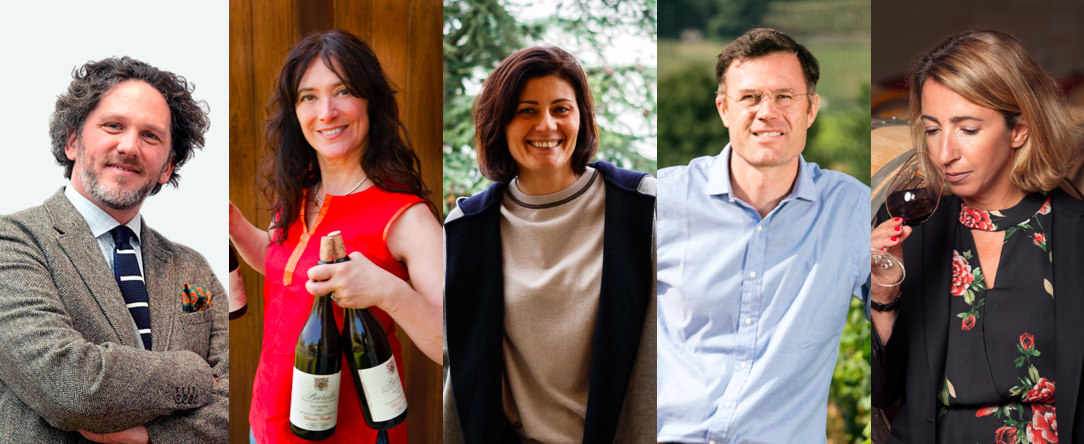 From left to right: Axel Heinz, Chiara Boschis, Gaia Gaja, Jacques Devauges, and Marielle Cazaux
From left to right: Axel Heinz, Chiara Boschis, Gaia Gaja, Jacques Devauges, and Marielle Cazaux
Axel Heinz – Ornellaia
“It’s certainly the most difficult question to answer for a winemaker”, Axel begins. Born in Germany, and spending his early career in Bordeaux before joining Ornellaia, his choice, once we twisted his arm, sits far from his professional vinous journey. “It would be a white, from my favourite Grand Cru in Burgundy: Corton Charlemagne”, he confesses, explaining that for him, these wines combine the structure and power of a red wine, with “the vibrancy, fragrance, and minerality that one can only find in great whites”. Admiring its capacity for a faithful expression of terroir, and display of true personal signature, he cites Coche-Dury as his go-to producer.
Chiara Boschis – E.Pira e Figli
With Barolo in her blood (her relatives founded the historic Giacomo Borgogno estate), it is not unusual that Chiara Boschis’ favourite wine should hail from this same noble Italian region. She tells us that she understood from a young age “the privilege to be born in such a generous land”, for which her parents, and the people around her had “great love and respect”. After years in the cellar at E.Pira, she too became “entirely captured by the magic of Barolo”. Chiara’s top choice is therefore a Barolo from the Mosconi vineyard for its “complexity and depth”, Cannubi for its “elegance”, and the vineyards of Via Nuova for their “diversity”.
Gaia Gaja – Gaja
While paying homage to her family’s past through her own wines, fifth generation winemaker, Gaia Gaja also has one eye on the future. Her favourite wine, from rising star appellation Mount Etna, Sicily, is Graci’s Etna Rosso Arcuria. The wine is made from one of the latest ripening European varieties, Nerello Mascalese, in one of the highest vineyards in Europe. She discovered it after “becoming close friends with Alberto Graci and his family”, often visiting them in Etna. Gaia explains that “the contrasts between its vibrancy, freshness, and warmth, as well as its perfume and smoky minerality”, remind her of “the snow and the fire of Etna”. Comparing it to Nebbiolo, she believes the grape has “intriguing personality, a strong identity of place, and a medium body that makes it versatile and easy to drink”.
Jacques Devauges – Clos des Lambrays
Moving from Clos de Tart to Clos des Lambrays last year, Jacques Devauges’ top wine of all-time was born close to home. He tells us that Comte Georges de Vogüé’s Musigny catalysed his passion for wine. Sampling the 1971 and 1978 as a teenager, he was “struck” by both, despite knowing very little about wine at that point. Jacques believes Vogüé’s Musigny shows “the signature of the Grand Vin”, to impress “not only the wine geek, or the collector, but everyone, even those who don’t know what makes a good wine”. Describing what “was almost a shock”, he notes that the “level of perfume on the nose was almost like a perfume you can put on your skin”, while the palate was “soft and delicate”.
Marielle Cazaux – La Conseillante
Joining La Conseillante from neighbouring Petit-Village in 2015, Marielle Cazaux tells us that if she had to pick a favourite wine, it would be Ridge Vineyards Monte Bello, because she “has so many special memories with this wine”. As an intern at Ridge in 2001, she had the chance to taste several vintages with the legendary Paul Draper, whom she calls “one of the most gifted winemakers of the US”. Marielle considers Monte Bello a “wine with extraordinary finesse”, and “a total sense of harmony”. Describing its notes of “black pepper, lavender, mocha, liquorice, and dried flowers”, she observes that it is “perhaps one of the most “Bordeaux” style wines in California”.
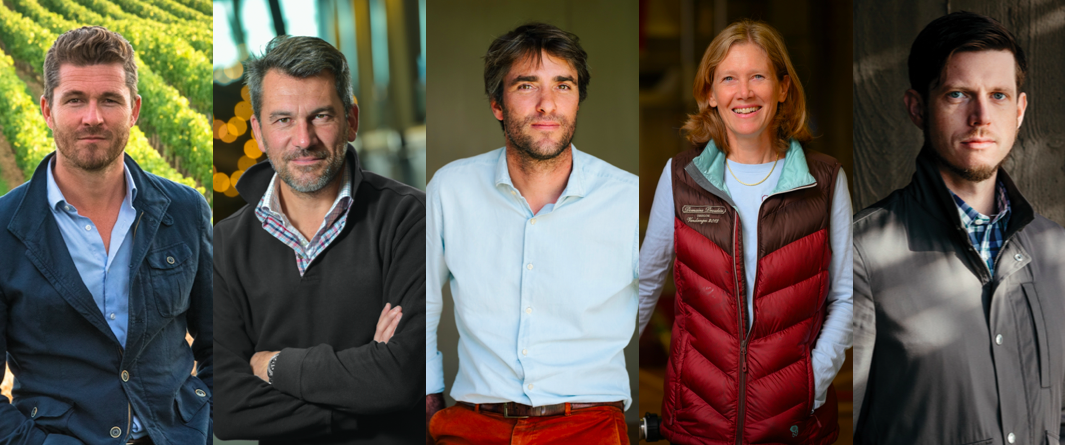 From left, Nicolas Audebert, Nicolas Glumineau, Pierre-Olivier Clouet, Veronique Boss Drouhin, and Will Harlan
From left, Nicolas Audebert, Nicolas Glumineau, Pierre-Olivier Clouet, Veronique Boss Drouhin, and Will Harlan
Nicolas Audebert – Rauzan-Ségla, Canon, and Berliquet
With some of the world’s most prestigious wineries under his belt (Terrazas de Los Andes, Cheval des Andes, Moët & Chandon, Krug, Veuve Clicquot), Nicolas echoes Axel Heinz in attempting to pick his favourite wine: “it’s impossible to answer. It’s like music – endless, initiatory, and progressive”. He instead recommends a wine from his friend, winemaker Andrea Felluga, with whom he “shares wine at simple, festive tables with lots of laughter”. He tells Wine Lister that Felluga’s wine, Livio Felluga Terre Alte “is a great white from Friuli” – a “land of contrast between the sunny and singing soul of Italy and the Alpine foothills, austere and cool”. Made from a blend of Friulano, Sauvignon Blanc, and Pinot Blanc, the Terre Alte is, according to Nicolas, like Felluga – “happy and lively”.
Nicolas Glumineau – Pichon Comtesse
On the subject of his favourite wine, Nicolas Glumineau (previously of Haut-Brion, Margaux, and Montrose), tells us that there are so many wines he could note – “Rayas 1990, E. Guigal La Mouline 1976, Cristal 1996, Trotanoy 2009, Diamond Creek Red Rock Terrace 2015”. White Burgundy legend, Coche-Dury, nonetheless gets another vote from Nicolas (on top of praise from Axel Heinz) as he reminisces trying the Meursault Caillerets 2006 for the first time in London, and being “choked, speechless, and moved by such perfection”. He describes the “delicacy of its white flower aromas and the elegance of its mineral and endless finish”, and recalls the feeling “that the world has stopped turning and that time has been suspended”.
Pierre-Olivier Clouet – Cheval Blanc
Echoing the sentiment of several of his peers, Pierre-Olivier Clouet (who has been at Cheval Blanc for 16 years), tells us that “it is impossible to choose just one wine”, because “like wine, the palate of the taster is constantly evolving”. Pierre-Olivier nonetheless notes his current favourite is “Mas Jullien – a wine that fully expresses the identity of the place where it is made, and injects the touch of balance and freshness that characterises all the great wines of the world”. He recalls that the last time he tasted the Languedoc red – a blend of Syrah, Carignan, and Mourvèdre – was with his team, on the last day of Cheval Blanc’s 2020 harvest.
Veronique Boss Drouhin – Joseph Drouhin
Fourth-generation winemaker, Veronique Boss Drouhin tells us that a wine she particularly enjoys was introduced to her by her close friend, Christine Vernay, daughter of the late Georges Vernay (praised for his key role in the survival of the Condrieu appellation). Veronique recalls Vernay opening a bottle of Georges Vernay Condrieu Coteau de Vernon, and being enchanted by its “aromatics, jumping out of the glass – unique, fragrant, and complex”, and a palate that was “powerful, voluptuous, and round, but with acidity to balance it” – a rarity for Viognier. She also cites Georges & Christophe Roumier’s Chambolle-Musigny Les Amoureuses as one of her favourites, adding, “Christophe’s [wine] is one of the nicest, purest, more elegant expressions of Pinot”.
Will Harlan – Promontory
Leading Harlan Estates‘ second-generation venture, Will Harlan explains to us that while he cannot choose a favourite, Jacques-Frederic Mugnier’s Musigny 2001 is a wine that he believes to “belong among the finest”. Will recalls coming across the bottle while “travelling with colleagues through Copenhagen a few years ago”, and as there hadn’t been a correct time to open it, the bottle joined them “on a course through Germany to Switzerland”. Having finally found an appropriate evening in Zurich to open it, “by the lake — the first bit of rest since the trip began”, he was “drawn in, as each feature of the wine, with a humble nobility, felt very naturally and confidently in its place”. Will notes it was a “wine that was singular and true”, that “would mark a memorable evening of our travels and in our friendships”.
The first of the Burgundy 2019 en primeur releases began this month, reigniting conversation of last year’s growing season, and its subsequent offerings. Wine Lister has spoken to several key Burgundy producers, and has sampled the 2019s from leading négociant, Louis Jadot, to get a better picture of this promising vintage.
Burgundy’s 2019 growing season was marked by a notably hot and dry summer, resulting in wines of extreme concentration. Due to a combination of spring frost, uneven flowering, and summer drought across many sites, yields in 2019 are significantly lower than average.
 A line-up from Louis Jadot’s 2019 en primeur tasting, organised by Hatch Mansfield at Vagabond, Monument on the 3rd of November 2020
A line-up from Louis Jadot’s 2019 en primeur tasting, organised by Hatch Mansfield at Vagabond, Monument on the 3rd of November 2020
Sourcing grapes from across the region, including its own holdings in some of Burgundy’s most prized plots (e.g. Chapelle Chambertin, Clos Vougeot, and Vosne-Romanée), Louis Jadot’s production in 2019 is down 50% for Chardonnay, and 30% for Pinot Noir. A cool and windy spring caused millerandage across Jadot’s sites, leading to many of the smaller, unripe berries being discarded. Warm temperatures in 2019 meant that grapes had high natural sugar levels, and correspondingly high alcohol across the region. Deputy General Manager, Thibault Gagey, tells us that several Louis Jadot wines are approaching 14 degrees in 2019, however, they nonetheless offer “good acidity, so they are powerful but balanced”, and there “isn’t a feeling of high alcohol”.
Wine Lister agrees whole-heartedly, and was particularly impressed by the quality of the whites. The Chablis Blanchot was “pure and lithe with an already-sumptuous texture”, while the Chassagne Montrachet Morgeot Clos de la Chapelle offered a delightful nose of “honey, truffle, and brioche”, with “rich citrus” on the palate. For reds, Wine Lister enjoyed the “complex and earth-toned” Clos Saint-Denis, and the “powerful but poised” Gevrey-Chambertin Clos Saint-Jacques. Gagey informs us that he is indeed “very proud of the 2019s”, and is “confident that it will be a good vintage”.
Across the Côte de Beaune, harvests were small in 2019. Arnaud Ente tells us that his namesake domaine saw “a spell of spring frost”, which caused significant damage and loss of yield, and “uneven weather patterns during flowering”, caused coulure and millerandage. The summer was mostly hot and dry, causing hydraulic stress to the vines, but “20-30mm of rainfall in late August” helped to unblock phenolic maturation, and allow the grapes to reach “impressive levels of maturity while maintaining good sugar levels, and also a very lovely acidity”. Ente notes that his 2019s have achieved “extraordinary balance, due to the acidity in the grapes developing slowly”. The vintage is of “enormous potential”, if down 20% on an average year in terms of volume.
Domaine Jean-Noël Gagnard similarly experienced significant frost in 2019; the principal cause of its small harvest. Winemaker Caroline Lestimé echoes the experience of “millerandage followed by hydraulic stress on the vines during the summer drought”, resulting in “small, but thankfully exceedingly concentrated berries”. Due to the two extremes of conditions throughout the season, Lestimé analysed the sugar / acid balance frequently near to harvest, so as to pick the optimum window for picking. Once again, quality here is likely a triumph, but Lestimé adds that “Jean-Noël Gagnard has not seen such a small harvest since 1999”.
Guillaume d’Angerville tells us that in Volnay, “frost risk was on everyone’s mind”, however, “dry and windy conditions helped to avoid frost damage” across Marquis d’Angerville’s plots. Water and heat stress in summer was a problem here too, “stopping the plant’s evolution, and veraison was delayed as a result”. He similarly explains that “selecting the correct harvest date proved difficult”, in part due to the “heterogenous grape maturation”, however in the end, “the entire range benefitted from the perfect maturity of the grapes”, despite yields being down 20-30% on the average year. He tells us that his 2019s are “succulent and full of energy”, without being “jammy” from such a hot year, and therefore providing “another successful vintage ending in 9”.
Akin to Louis Jadot, Winemaker Jean-Nicolas Méo tells us that Méo-Camuzet’s 2019s are “well-ripened”, with “fairly high alcohol levels, around 14 degrees”. He states that there is nonetheless “a nice acidity to start”, which provides the wines “a good freshness and a certain structure”, as well as lengthy ageing capacity. Echoing d’Angerville’s sentiment on the success of 9s, Méo foresees “an evolution of this vintage like the 2009: rich and greedy at first, then gradually closing, to emerge in a decade more tense and structured than suggested today”.
Despite the significantly reduced volumes in 2019, the quality of Burgundy’s latest vintage release clearly suggests a long and promising future ahead. The combination of these two factors will surely see demand outweigh supply for en primeur once again. For more guidance on buying Burgundy 2019 en primeur, and essential analysis to inform your wider Burgundy investment decisions, purchase our in-depth Burgundy study here.
Wine Lister’s recent in-depth Burgundy study considers the much-contended topic of the region’s rising prices, providing additional information for those planning on purchasing Burgundy 2019 en primeur over the coming months.
Below we examine the current distribution of prices of the 175 wines featured in the study, compared to the same wines two years ago. While 5% of wines were priced above £3,000 two years ago, a substantial 11% are today.
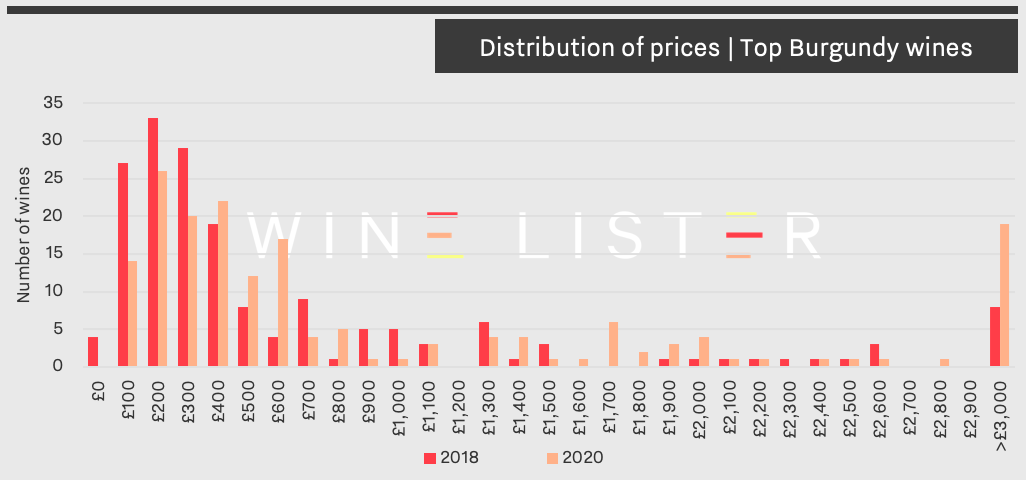
The graph above reveals a significant shift towards the higher end of the price scale, with multiple Burgundy wines previously priced between £1,900 and £2,700 now over £3,000. This comprises Comte Liger-Belair La Romanée, d’Auvenay’s Mazis-Chambertin and Bonnes-Mares, Domaine de la Romanée-Conti La Tâche, Jean-François Coche-Dury Corton-Charlemagne, and Leroy’s Richebourg, Romanée-Saint-Vivant, Clos de la Roche, Corton-Charlemagne, and Latricières-Chambertin.
Alongside the figures, feeling from Wine Lister’s recent Founding Member survey confirmed that Burgundy’s seemingly boundless prices are a concern, with over half of respondents voicing apprehensions on the topic. The most common sentiment is nonetheless that little will change for wines at the very top end, and that their prices will continue to climb, as demand continues to outweigh supply significantly. One specialist merchant in the Asian market informed us that they indeed foresee “Burgundy prices heading higher at the top end”, and that they “don’t see demand slowing despite the economic issues.”
The polarised prices illustrated in the graph are echoed by the trade, who cite a phenomenon of divergence between the top-end wines, and those at mid-range or entry-level. One respondent noted “an oversupply of generic and village Burgundy”, with another predicting that “when the smoke clears, all that remains will be Bourgogne Rouge/Blanc and the crown jewels, with no market in between”.
Despite the geopolitical context of the past two years, the buzz surrounding Burgundy remains strong, and competition will be hot for accessing the best wines of the 2019 vintage, particularly given its reduced production volume.
Visit the Analysis page to purchase Wine Lister’s in-depth 2020 Burgundy study, or download it using your Pro subscription here (available in both English and French).
Before the bulk of Burgundy en primeur 2019s are released onto the market, Wine Lister has published its second in-depth Burgundy study.
Below we explore the complex relationship between the region’s price performance and its popularity growth over the past two years, informing your investment decisions over the coming months.
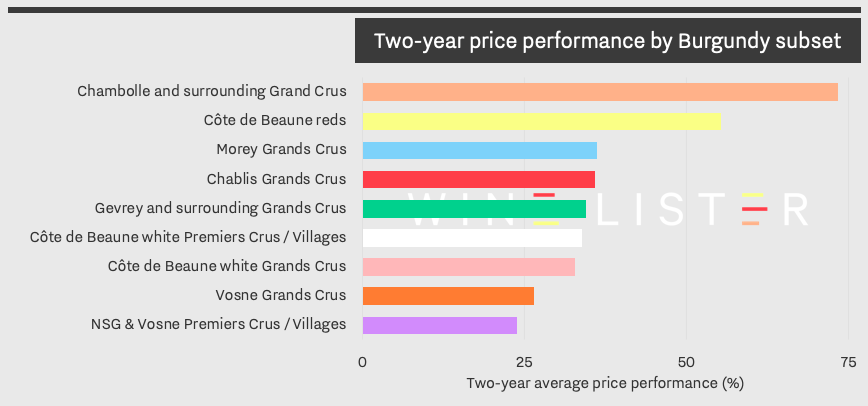 The two-year price performance of a basket of 175 Burgundy wines (the same wines featured in our previous study on the region in 2018), based on the last 30 vintages. Price data partner: Wine Owners.
The two-year price performance of a basket of 175 Burgundy wines (the same wines featured in our previous study on the region in 2018), based on the last 30 vintages. Price data partner: Wine Owners.
As shown in the chart above, Chambolle and its surrounding sites lead in the price performance of Burgundy Grand Crus, followed by wines hailing from its northerly neighbour, Morey-Saint-Denis. The notorious sub-set of Grand Crus from around Vosne – home of legendary Richebourg, La Tâche, Echezeaux, and Romanée-Conti – has seen slower price performance, which is matched with lower popularity growth (see below).
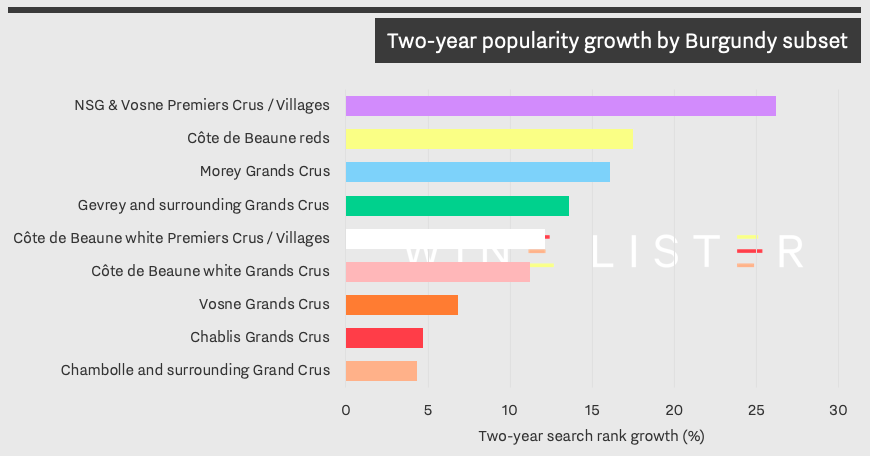 The two-year popularity growth of each Burgundy subset. Popularity data partner: Wine-Searcher.
The two-year popularity growth of each Burgundy subset. Popularity data partner: Wine-Searcher.
Though Chambolle and its surrounding Grand Crus have excelled in two-year price growth, consumer interest in the wines of this subset increased the least. Following similarly this opposing relationship between the two data sets, Nuits-Saint-Georges / Vosne Premiers Crus and Village wines gained the most popularity over the last two years by a large margin, while the subset’s price performance trails behind in last place.
A growing interest in lower-priced wines from Burgundy is further explored through trends identified by key members of the international fine wine trade in Wine Lister’s report. Producers such as Arnoux-Lachaux and Georges Mugneret-Gibourg are well worth looking out for when buying Burgundy en primeur for drinking in several years’ time.
Visit the Analysis page to purchase Wine Lister’s in-depth 2020 Burgundy study, or download it using your Pro subscription here (available in both English and French).
Burgundy prices continue to rise, and top wines are becoming ever-harder to access – but must what goes up really come down?
Wine Lister has published its second in-depth Burgundy report, with contribution from partner critic and leading Burgundy expert, Jasper Morris. With insights from key fine wine trade players from across the globe, the report investigates the state of Burgundy compared to other major fine wine regions, and discusses projections for its future performance.
Please see our key findings below:
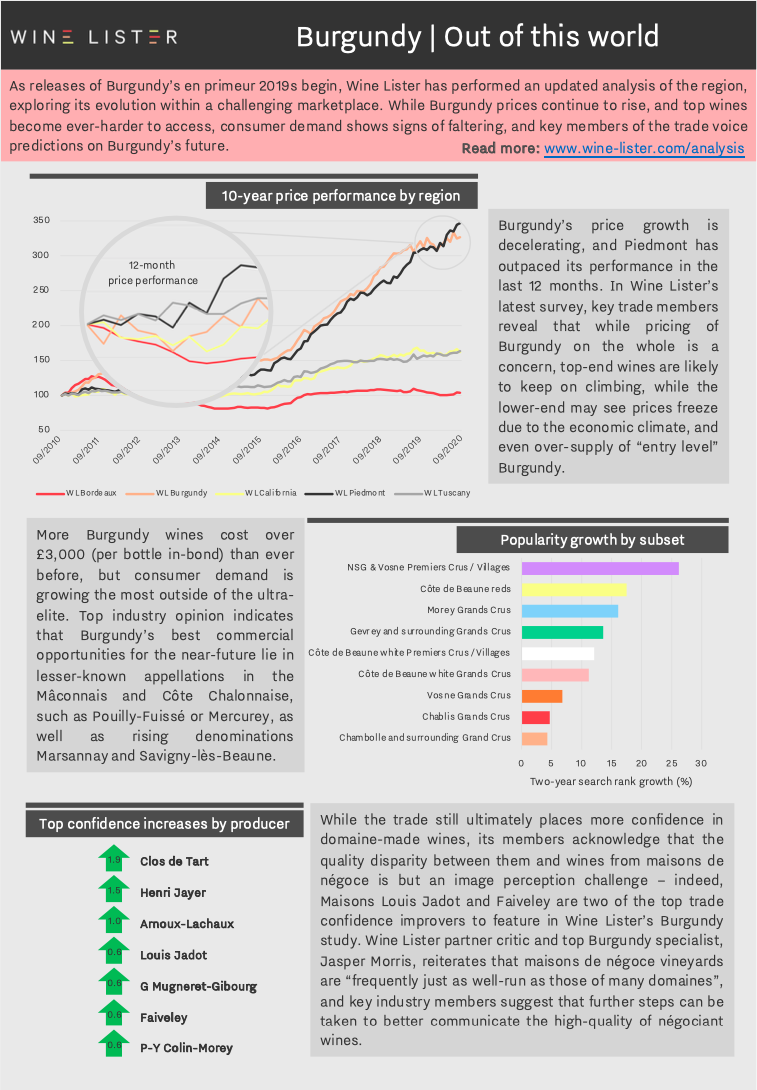
You can download the study digest in English here: Wine Lister Burgundy Study Digest 2020 or French here: Wine Lister Étude Bourgogne 2020 – Résultats Clés. The full report can be purchased on our Analysis page, while Pro subscribers can access their free copy here.
As much of Europe re-enters lockdown, the fine wine industry is once again adapting through the digital world. With many reliable retailers now running e-commerce platforms, there is simply no excuse not to purchase top-quality wine from the comfort of your own home. To help you get the best from your online buys, Wine Lister offers its top tips on avoiding compromise on your acquisitions, whether for drinking or for laying down in the cellar.
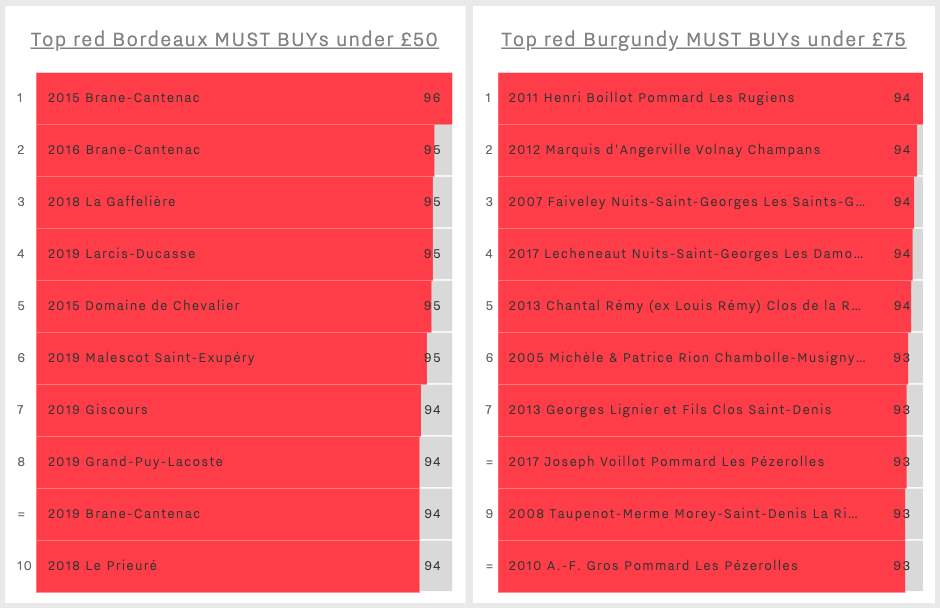
- Narrow down your drinking delights
With a plethora of brilliant bottles now available to purchase online, Wine Lister’s free tools provide a good place to start your decision journey, helping you to refine your browsing before you even begin. On top of our MUST BUY recommendation algorithm, our Wine Leagues provide top-10 lists of the best wines to source for given categories, be it appellation, price, or WL score (a quality measure comprising ratings from Wine Lister’s partner critics). Featured on the individual wine pages, Wine Lister’s drinking windows inform you of the best time to open your bottle, another key factor to consider when buying wine. The above sets of Wine Leagues reveal the top Bordeaux reds for under £50 (per bottle in-bond) and the top Burgundy reds for under £75.
- Elect an esteemed merchant
Whether you have determined what you want or not, it is crucial to buy only from trusted merchants. While pricing may vary, Wine Lister recommends sticking with reputable retailers to ensure top-notch provenance and delivery. The list of legitimate options is long, but we suggest the following (to name but a few): Berry Bros & Rudd, BI Fine Wines, Corney & Barrow, Goedhuis & Co, Justerini & Brooks, Lay & Wheeler, and Vinum Fine Wines.
- Refine through regional specialists
If your focus is on one region in particular, it can be beneficial to buy from specialist merchants. For example, Stannary Wines represent several top Burgundy producers, and Armit Wines are the agent for a number of leading Italian estates, providing dependable platforms for you to direct your search. It is useful to know which merchants are the primary UK importers of specific domains, for example, Justerini & Brooks represent Philipponnat Clos des Goisses, and Four Corners work with many top Californian fine wines.
For more industry insights and advice on which wines and regions to buy, sign up for Wine Lister’s free newsletter here.
“Finché c’è vino c’è speranza” – As long as there is wine, there is hope.
Never before have Italian winegrowers been able to dedicate as much time to the care of their vineyards as in 2020. The Consorzio Vino Chianti Classico and several further Tuscan producers cite this silver lining to Covid restrictions, and they suspect it will reveal itself in the wine to come. In a year that has caused tribulation across the world, news of Italy’s promising 2020 harvest is certainly welcomed. Wine Lister has spoken to several Italian estates, which reportedly yielded high-quality grapes across the board. While regions – Piedmont and Tuscany – had their respective weather nuances, the general consensus suggests that growing season conditions were balanced, with no mention of hail or storms.
In Montalcino, the Mastrojanni team explained that lockdown prompted improved vineyard inspection in 2020: “[people] couldn’t work indoors in their offices, so the vines received the utmost attention”. They report a “very good harvest” this year, comparing it to the high-scoring 2013. Despite two short heatwaves in July and August, the estate had a mild summer overall, thanks to cooling winds that flow through the Amiata Valley in which its vineyards are situated.
On the other side of Montalcino, Cinelli Colombini reported frost during budburst, which limited the number of grape clusters in 2020. Several other Tuscan producers spoke of reduced volumes due to the cold start to spring (Fattoria Le Pupille’s 2020 yield is 20% lower than last year). Cinelli Colombini’s Brunello grape harvest was nonetheless of “excellent quality”, and despite it being hard to “shine after a masterpiece of a vintage like 2019”, the team believes it will be “difficult to exclude it from being among the best five vintages of the last 20 years”.
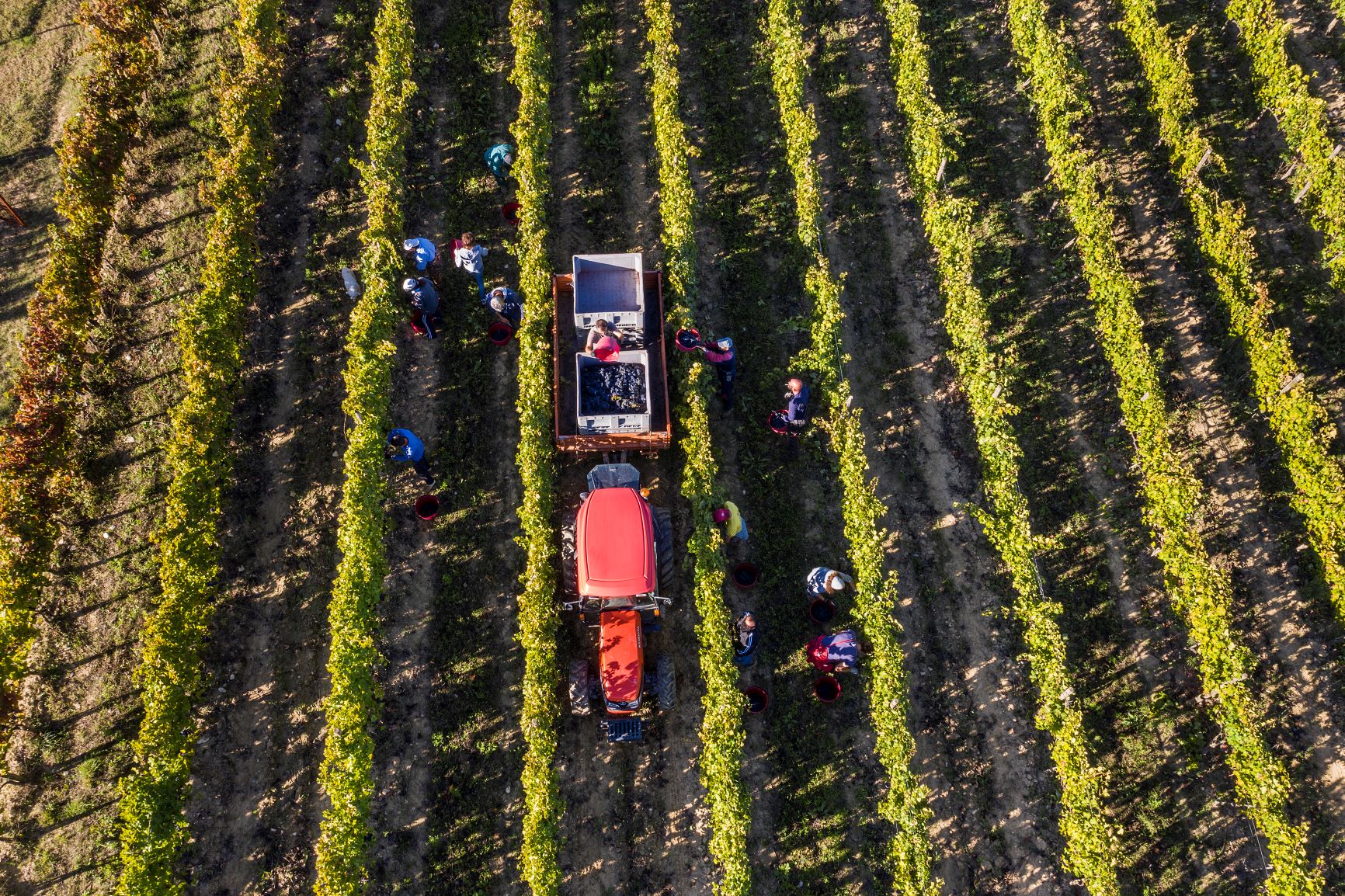 All hands on deck: the 2020 Brunello harvest at Montalcino’s Cinelli Colombini
All hands on deck: the 2020 Brunello harvest at Montalcino’s Cinelli Colombini
In Chianti, Castello di Monsanto began picking its Chardonnay grapes on 8th September, and collected its final Sangiovese on 10th October. Third-generation owner, Laura Bianchi, informed us that their spring was mild, with enough rain to create a “perfect” reserve of water for the vines. After the hot and dry August, a wet start to September helped to regulate maturation – a common theme throughout Tuscany in 2020. The grapes thus developed a “great balance of sugar, pH, and phenolic maturation”, and the first fermentation already suggests a vintage of “great personality, rich tannins, and beautiful acidity”. Further east, Vecchie Terre di Montefili started picking on 29th September – late in comparison to other producers, but normal, the team explains, for their vineyards, which lie 500 metres above sea level (and therefore require a longer maturation period).
Less than an hour away, Brancaia finished its harvest on 30th September (having started on the 3rd week of August). The team tells us that they were forced to harvest their Sangiovese quickly before heavy rain arrived, but that they were lucky that the grapes were “the perfect grade of ripeness”. In contrast, IPSUS owner, Giovanni Mazzei, explains that he and winemaker Gionata Pulignani decided to wait until after the extra rain in September before starting the harvest, “to guarantee more balance, extra aromatics, and temper the alcohol content”. In doing so, the hot and dry summer was counterbalanced; Mazzei states that he could indeed “classify the [2020] as a good compromise between cooler and hotter vintages”.
In coastal Maremma, owner and Production Manager at Fattoria Le Pupille, Ettore Rizzi, tells us that 2020 saw a significant threat of powdery mildew across its vines, especially in the thin-skinned varieties of Sangiovese, Ciliegiolo, and Syrah. He states that they nonetheless managed to trim the affected bunches and stem the problem, while their Merlot and Cabernet vines also “gave us some incredible fruit”. According to Rizzi, “the word that can best describe the 2020 vintage is concentration” – a consequence of the high temperatures in July and August.
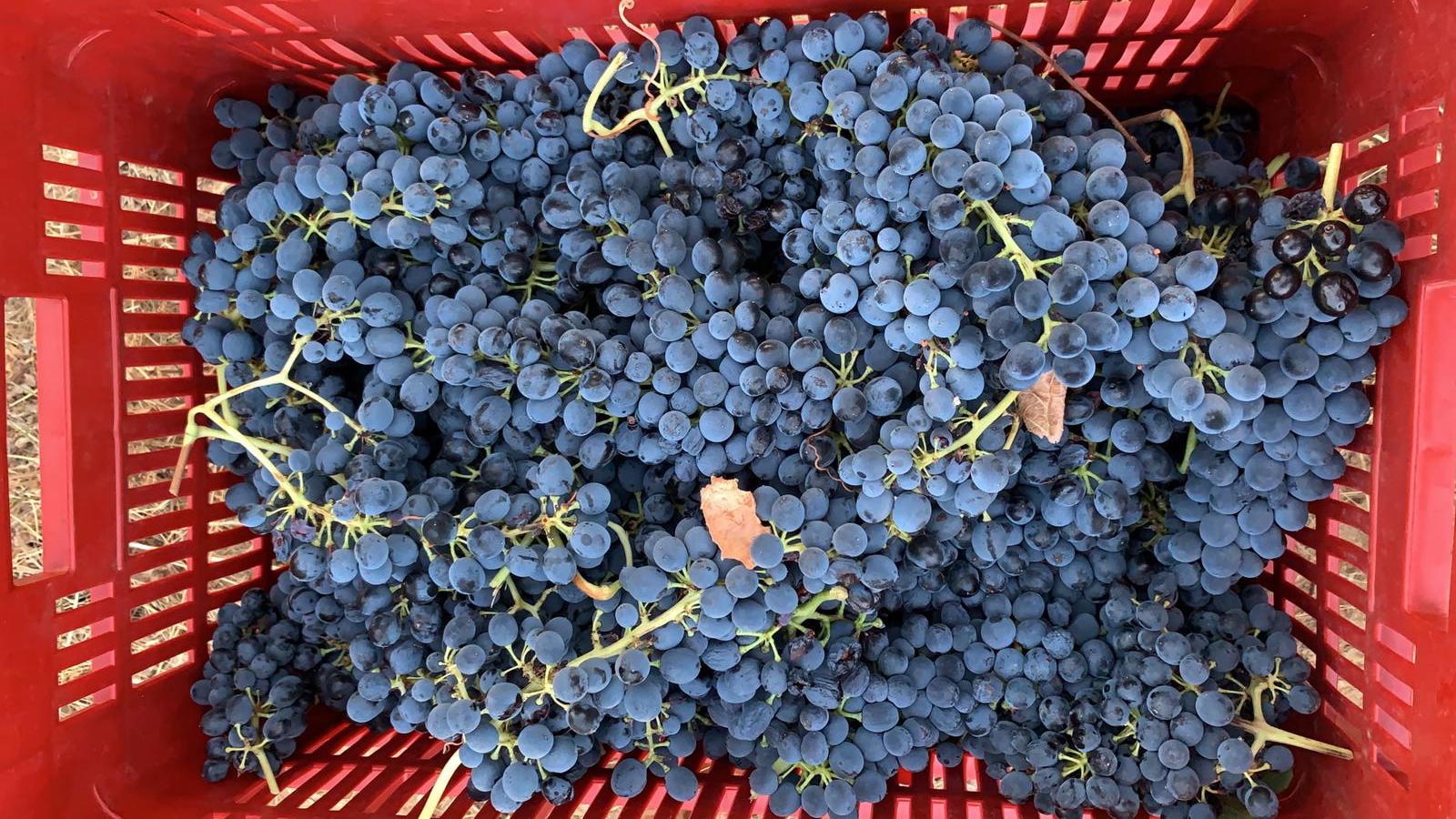 “The final quality of the grapes was really good” – Fattoria Le Pupille’s 2020 Syrah grapes
“The final quality of the grapes was really good” – Fattoria Le Pupille’s 2020 Syrah grapes
In Bolgheri, Ornellaia’s Estate Director, Axel Heinz, declared that their 2020 vintage is “shaping up to be one to remember as a great year”. The property saw “textbook perfect conditions until the end of May”, while June saw a lot of rainfall that “accelerated vine growth”, and required lots of work in the vineyard to keep the canopies under control. Summer saw hot and dry conditions, while rain arrived in the last days of August to alleviate drought stress and lower temperatures, encouraging a more even ripening at the last moment. While an unexpected mid-September heatwave made it necessary to pick all three red varieties – Cabernet Franc, Cabernet Sauvignon, and Petit Verdot – simultaneously at speed, Heinz notes that they nonetheless look “very promising in a rich and structured style”.
Moving up to Piedmont, fifth-generation of the esteemed Gaja family, Giovanni Gaja, tells us that they are so far “optimistic” about the 2020 vintage, despite it being early days to evaluate the exact character of the grapes. Their Barbaresco plots witnessed a moderate July, followed by a warm August that was similarly alleviated by rain towards the end of the month. While they required extra efforts to prevent mildew attacks, the final picked grapes appear “very healthy”.
While 2020 has caused much uncertainty, the recent harvest suggests that there is definitely hope for some excellent wine to come from this year, and we look forward to finding out for ourselves in the future.
Despite this year’s unparalleled circumstances, mother nature has had no choice but to persevere – members of the Wine Lister team visited Bordeaux during September, to get a feel for the 2020 harvest. After a turbulent nine months, 2020 has reportedly yielded another excellent vintage for Bordeaux, though the region’s vines experienced their own set of ups and downs. Outside of its macro-economic turmoil, 2020 proved an uncertain growing season too, as microclimatic weather patterns appear to have been more influential than ever. Small areas on both banks experienced hail, and rainfall differed by hundreds of millimetres from one property to the next. With a bit of luck, this is a vintage the international trade will be able to taste by next spring – and it will need tasting, in order to gain a comprehensive understanding of the best examples of the vintage.
Common to several properties was an early start to harvest, with masked pickers dispersing across many vineyards up to two weeks ahead of a “normal” year. Indeed, Pavie began harvesting its white grapes (for Monbousquet Blanc) at the end of August – a fortnight earlier than last year. Merlot grapes began to be collected on the 21st of September – nine days earlier than in 2019 (pictured below on the 22nd September).
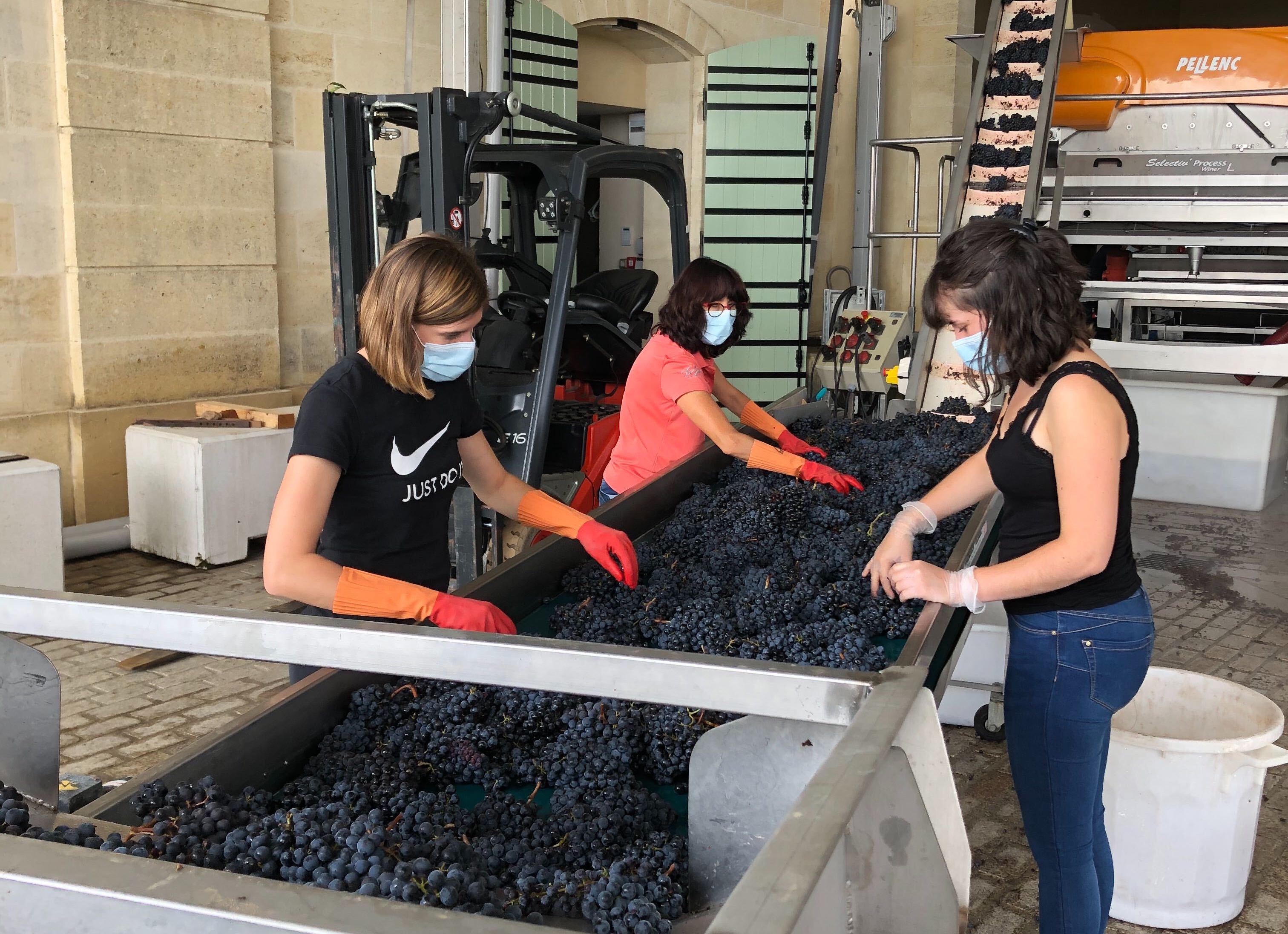 Masked workers sort Pavie’s 2020 Merlot grapes (22nd September 2020)
Masked workers sort Pavie’s 2020 Merlot grapes (22nd September 2020)
Pavie saw lower rainfall in 2020 than parts of the Médoc. The position of its vineyards at higher altitude on the south-facing slope of its renowned limestone plateau allows for both phenolic maturity and the retention of freshness. Its new Commercial Director, Olivier Gailly, notes that the mid-harvest showers also helped with the latter, freshening up the Cabernets prior to picking, and that subsequent high wind speeds dried the grapes, and prevented mildew from setting in.
Just a few kilometres north-west, Saint-Émilion star Angélus did not have a particularly early harvest in 2020, starting on the 15th of September – just three days earlier than last year. The estate saw mildew at the beginning of the season, which they managed to control ahead of a good flowering. Eighth-generation manager, Stéphanie de Boüard is confident in the new vintage, aligning it with the iconic 1947 or 2010 – “my father told me not to be ashamed to say it”, she notes of the comparison. Early analyses show the 2020 will likely be high in alcohol, but with a low pH, creating a freshness and an overall balance that was encouraged by mid-harvest rain. “This year picking dates have been more important than ever”, she adds, referring to the retention of fresh fruit, as opposed to more cooked aromas than can occur in warmer Bordeaux vintages.
Further north-west still in Pomerol, Beauregard also received much-needed rain during harvest, which similarly helped to soften the skins of its Cabernet grapes. Summer drought was more apparent here, repeating the 2018 phenomenon of hydraulic stress on the vines, and resulting in a smaller yield than 2019.
Moving to the Médoc, more properties saw the same hot and dry climatic conditions in 2020, resulting in instances of small grapes with high alcohol potential and lower acidity. In Margaux, d’Issan saw 16% potential alcohol in some of its early Merlot grapes (the highest ever recorded), and consequently welcomed the mid-September showers. Neighbouring Palmer anticipated the rain, and held off picking its Cabernet Sauvignon grapes until it came and went, ensuring the thinning of skins on smaller berries, and an overall reduction in alcohol percentage. The estate saw limited yields due to the dry summer, and Managing Director, Thomas Duroux, quipped that although “négociants would have liked a vintage with high volume and lower prices, [2020] will be a small vintage…” While he implies it might be more expensive than the trade had hoped, he nonetheless expects the 2020 to be “rich and exuberant”, sharing the power and concentration of 2018.
In Saint-Julien, owner of Branaire-Ducru, François Xavier Maroteaux describes a 2020 growing season of neat balance. The estate had a “wet post-harvest Autumn in 2019”, which helped to prevent drought stress throughout the new growing season. As the summer began to dry out, the estate saw 100 millimetres of rainfall in a short period (at the end of August), followed by a sunny and warm September. The season itself, Maroteaux muses, is similar to the 2011 vintage. He believes the resulting wine is worth excitement, after a steady and successful ripening, avoiding any disease.
In Pessac-Léognan, Malartic-Lagravière expects a concentrated wine in 2020, having also seen low volumes of mainly small berries due to the heat. Neighbouring Domaine de Chevalier echoed the sentiment, and we were surprised to hear from owner, Olivier Bernard, that there had not been a drop of rain at estate the day before our first visit (21st September), despite it raining throughout the same day in the Médoc, and in Bordeaux itself.
 The last day of picking at Domaine de Chevalier (30th September 2020)
The last day of picking at Domaine de Chevalier (30th September 2020)
“There have been lots of choices to make this year”, he continues – one of which no doubt was whether to trust the weather forecasts, particularly around harvest. With fewer planes flying around, forecasts were less accurate, and while rain fell further north, Pessac often remained dry. Bernard explains that the picking windows were tight in 2020: “instead of four days where the grapes are fine to pick, there’s one day” – since the drought and heat would cause alcohol to rise, and acidity to deplete quickly.
It seems therefore that we have another winemaker’s vintage on our hands. Mirroring somewhat the choppy commercial seas of this year, Bordeaux has had to navigate unpredictable viticultural waves too. What we have heard of the 2020 harvest thus far nonetheless leaves us hopeful, and anticipating eagerly the en primeur tastings of next spring.
Taittinger Comtes de Champagne 2008 was released yesterday (1st October) at c.£89 (per bottle in-bond), marking one of the last 2008s from the “Grandes Maisons” to enter the market. The release has reignited discussion on the success of the vintage in Champagne, which has been declared one of the best of the decade along with 2002. Below we investigate top 2008s, and where the latest addition from Taittinger fits within them.
Characterised by a consistent, dry, and cool growing season, climatic conditions in 2008 encouraged slow veraison across Champagne, which enabled grapes to achieve their full phenolic maturity while retaining acidity. The combination of both gives the vintage considerable ageing potential, and unyielding structural integrity.
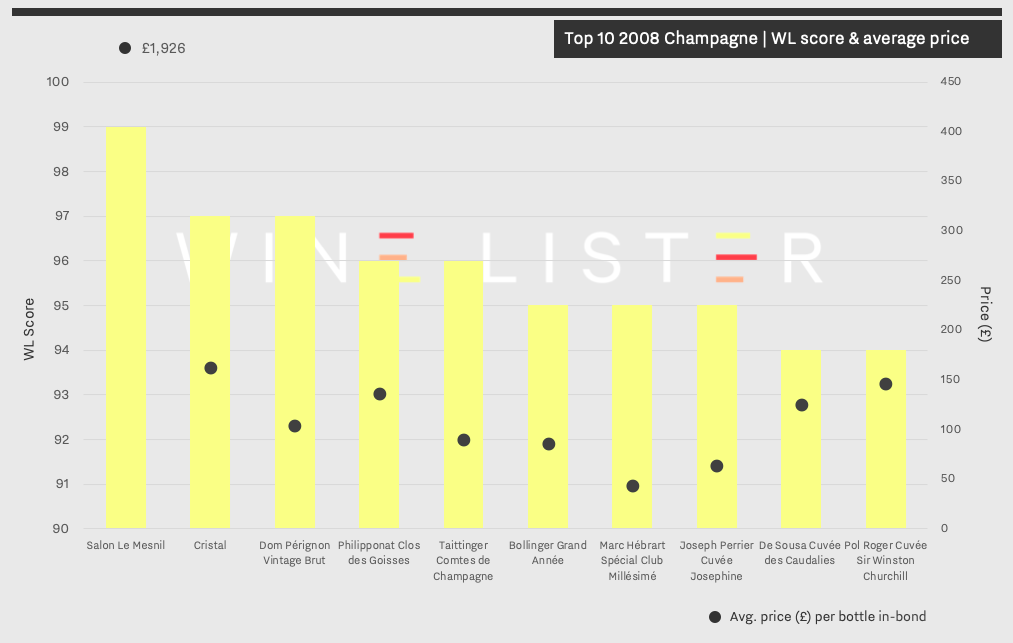
As illustrated above, the top 10 2008 champagnes by WL score exhibit impressive quality, with the top three wines gaining scores of 97 and above. This has not been achieved in the past four vintages, with Krug Brut Vintage 2003 being the most recent back vintage of a champagne to achieve a WL score of 97. Indeed, the top 10 champagnes gain an average WL score of 95.8 in 2008, compared to an average of 94.6 across the top 10 champagnes from the previous vintage.
The newest addition to the top 10 haul, Taittinger Comtes 2008 shows good value within the wider context of the vintage, despite entering the market at a 26% premium on the current market price of its 2007 vintage. While achieving the same WL score as MUST BUY Philipponat Clos des Goisses 2008 (96), Taittinger’s latest release is available for 34% less, (£89 vs. £135 per bottle in-bond). Similarly, it achieves one more WL point than Bollinger Grand Année 2008 (available for £85 per bottle in-bond), for a very slight premium.
Wine Lister partner critic, Antonio Galloni awards Taittinger Comtes de Champagne 2008 98+ points, stating it “is simply breathtaking” and “represents the purest essence of the Côtes des Blancs in a great, historic vintage”. He concludes, “readers who can find the 2008 should not hesitate”.
Taittinger Comtes de Champagne is historically one of the top 10 most liquid champagne brands, giving it further investment appeal. Additionally, Taittinger announced that it has not produced any 2009, 2010, or 2011 Comtes de Champagne, due to poor weather conditions during these years – a fact that may well increase interest in this latest release.
Also featured in the list of top 10 2008 Champagnes by WL score are: Salon Le Mesnil, Cristal, Dom Pérignon Vintage Brut, Marc Hébrart Spécial Club Millésimé, Joseph Perrier Cuvée Josephine, De Sousa Cuvée des Caudalies, and Pol Roger Cuvée Sir Winston Churchill.
Amid the flurry of releases from La Place de Bordeaux during September, an exciting development is said to be afoot from a wine grown on home turf.
We understand that Lafite 2018 – released last spring en primeur and currently still only available to purchase as such – will be bottled next year in special, 150 year anniversary bottles, complete with one-off anniversary labels.
The current average market price of Lafite 2018 is £533 per bottle (in-bond)*. Special bottlings typically induce significant price rises, particularly for Bordeaux first growths.
Mouton 2000’s special, gold-engraved bottle is priced almost four times higher than the average of Mouton’s recent back vintages (£1,558 vs. £398).
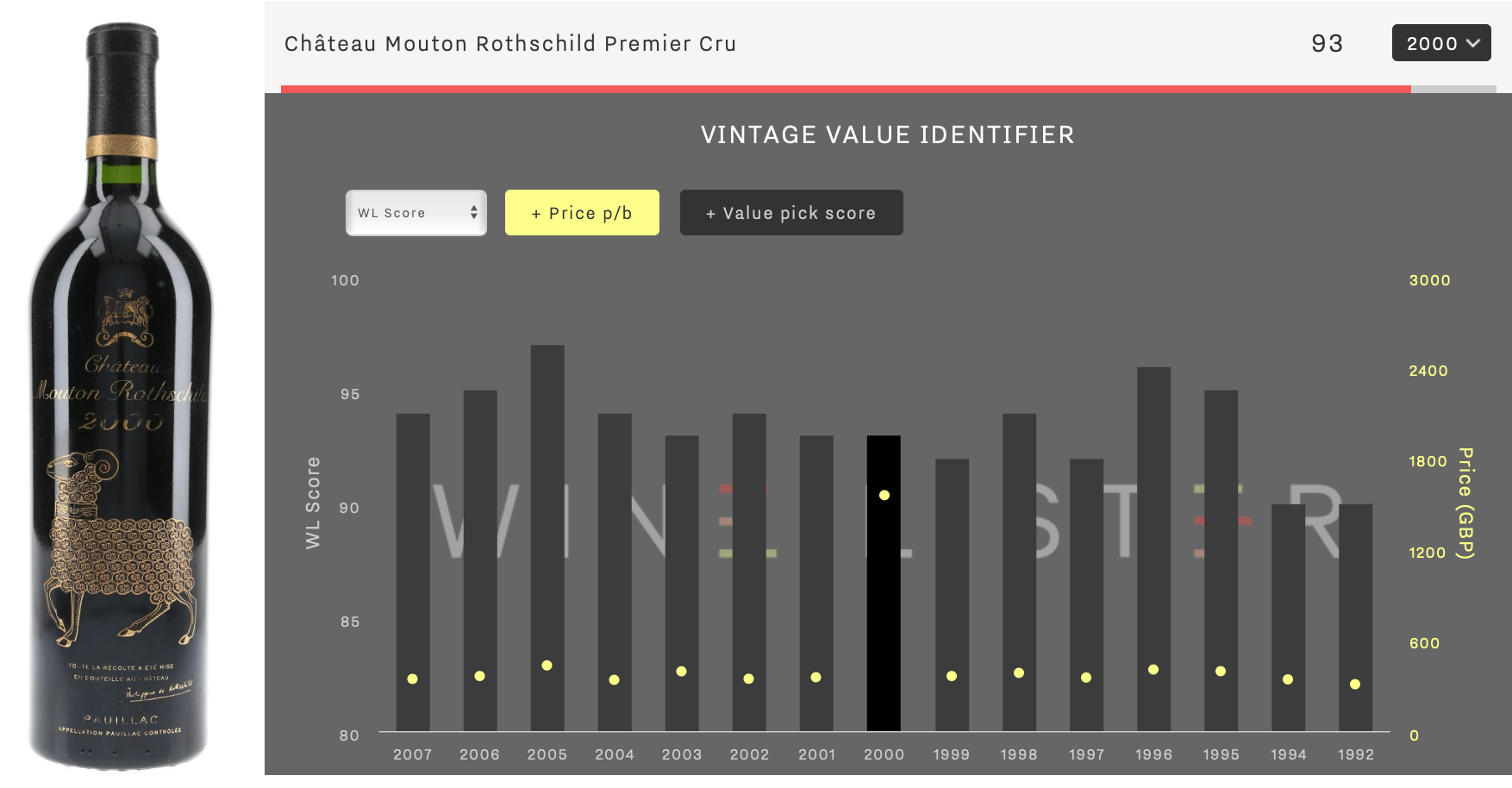
Similarly, the price of Margaux 2015, whose special bottle features a black label in memory of its winemaker, the late Paul Pontallier, has risen 64% since the commemorative bottling was announced.
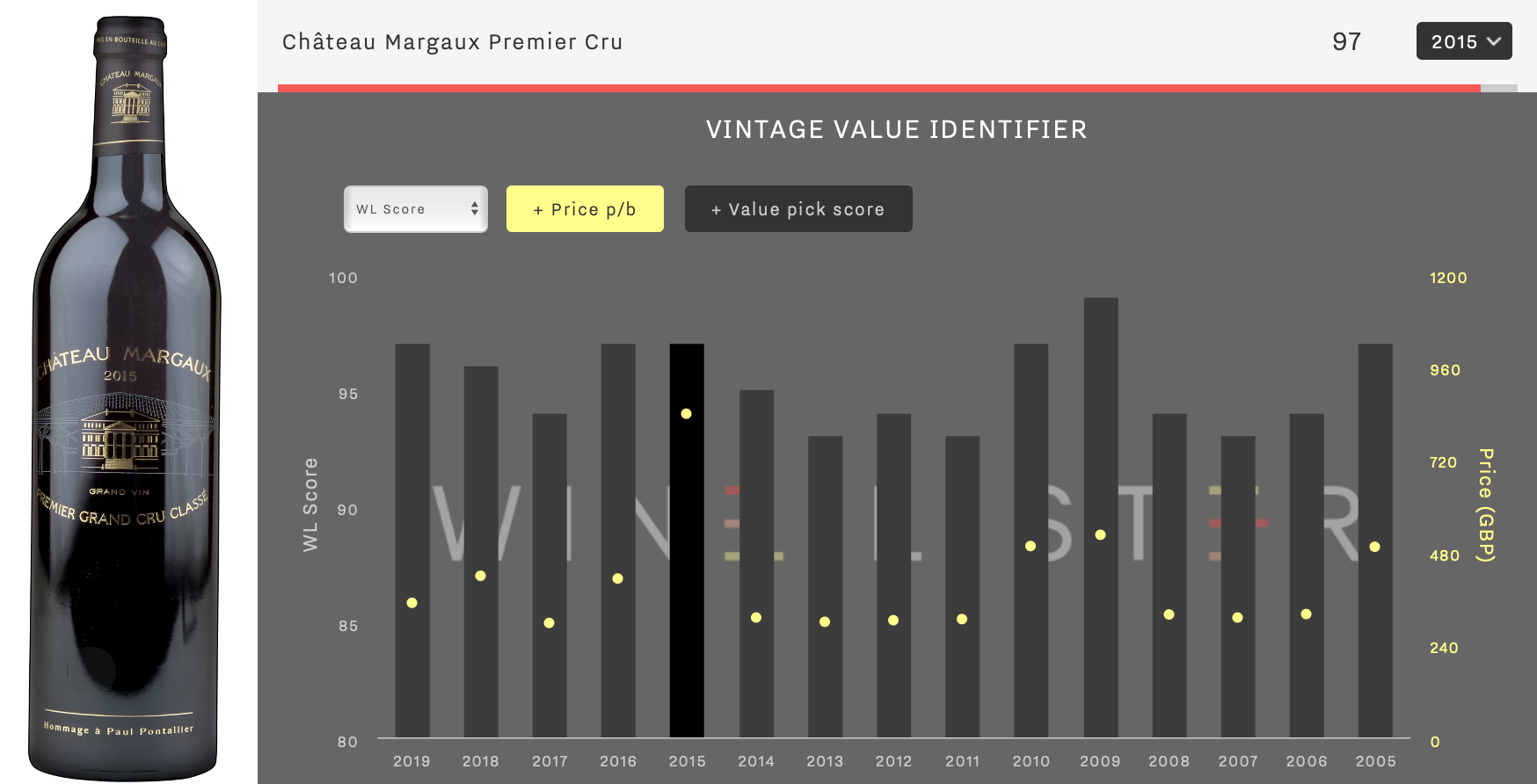
Prices of any remaining Lafite 2018 in the global marketplace are therefore poised to increase between now and the actual bottling of the wine, at which time we understand a small parcel of further, physical stock could be released by the château (presumably at a sizeable premium).
Lafite 2018 is currently an absolute MUST BUY.
*on date of publication, Thursday 17th September 2020
 From left to right: Axel Heinz, Chiara Boschis, Gaia Gaja, Jacques Devauges, and Marielle Cazaux
From left to right: Axel Heinz, Chiara Boschis, Gaia Gaja, Jacques Devauges, and Marielle Cazaux  From left, Nicolas Audebert, Nicolas Glumineau, Pierre-Olivier Clouet, Veronique Boss Drouhin, and Will Harlan
From left, Nicolas Audebert, Nicolas Glumineau, Pierre-Olivier Clouet, Veronique Boss Drouhin, and Will Harlan











